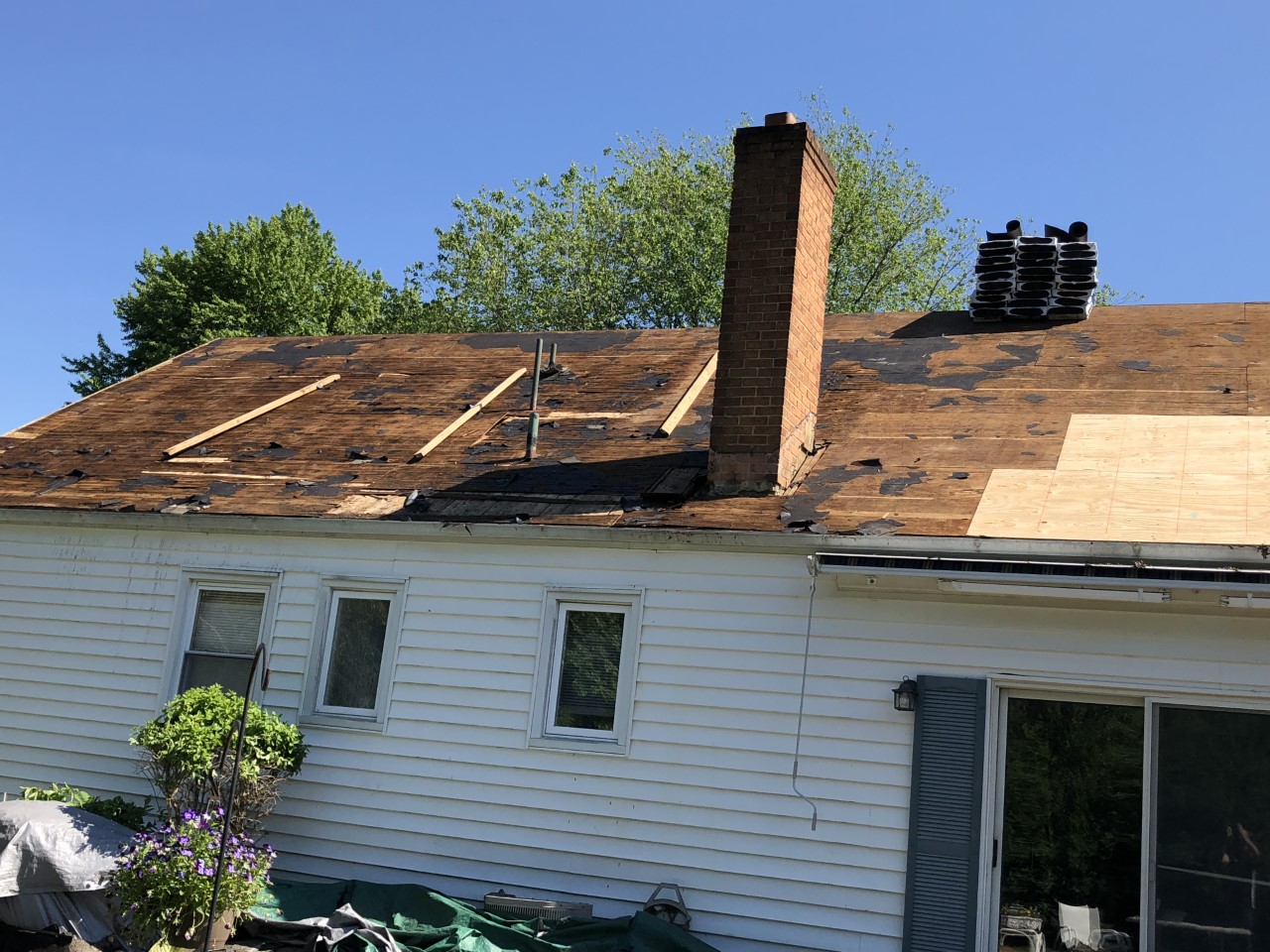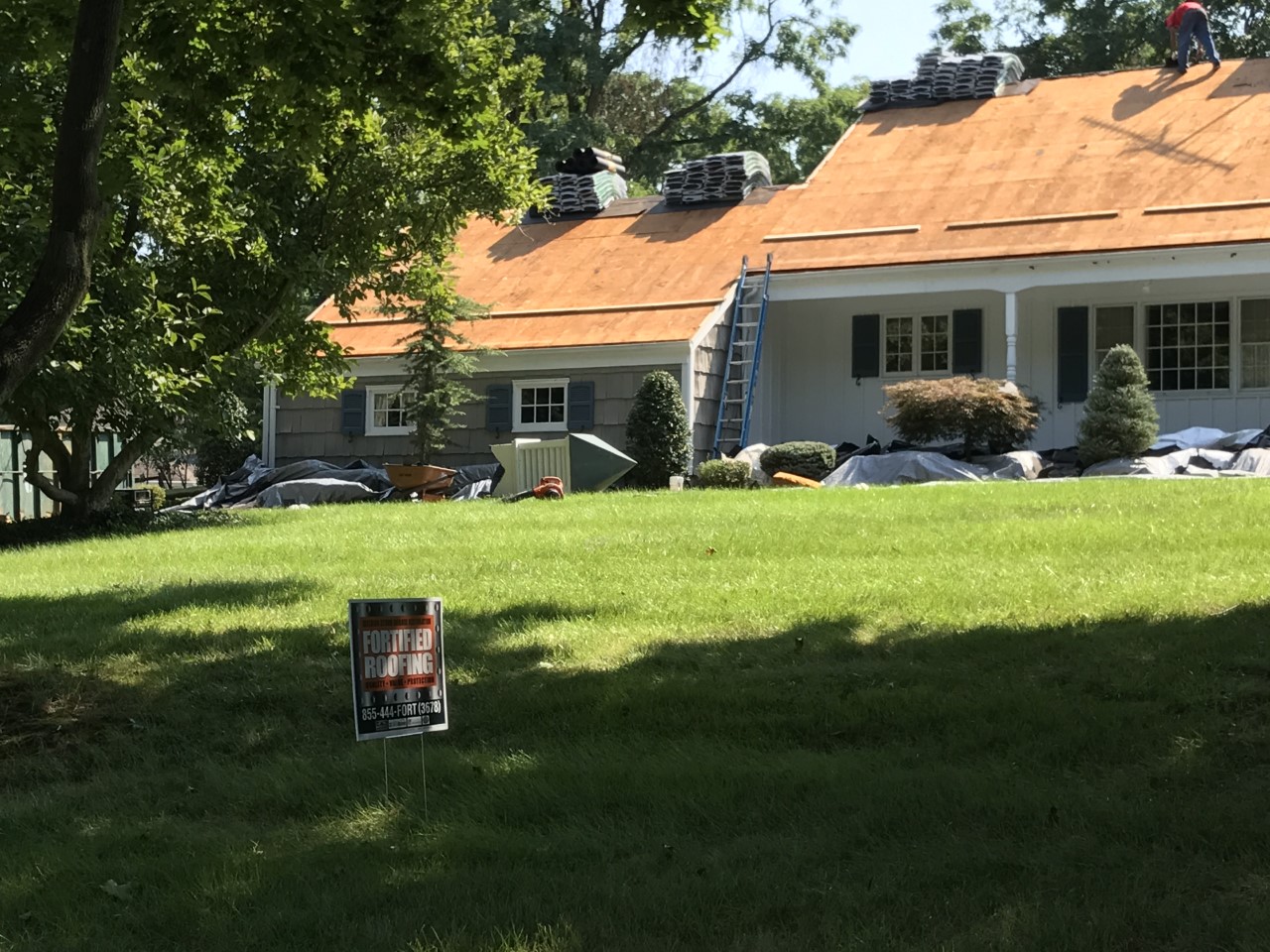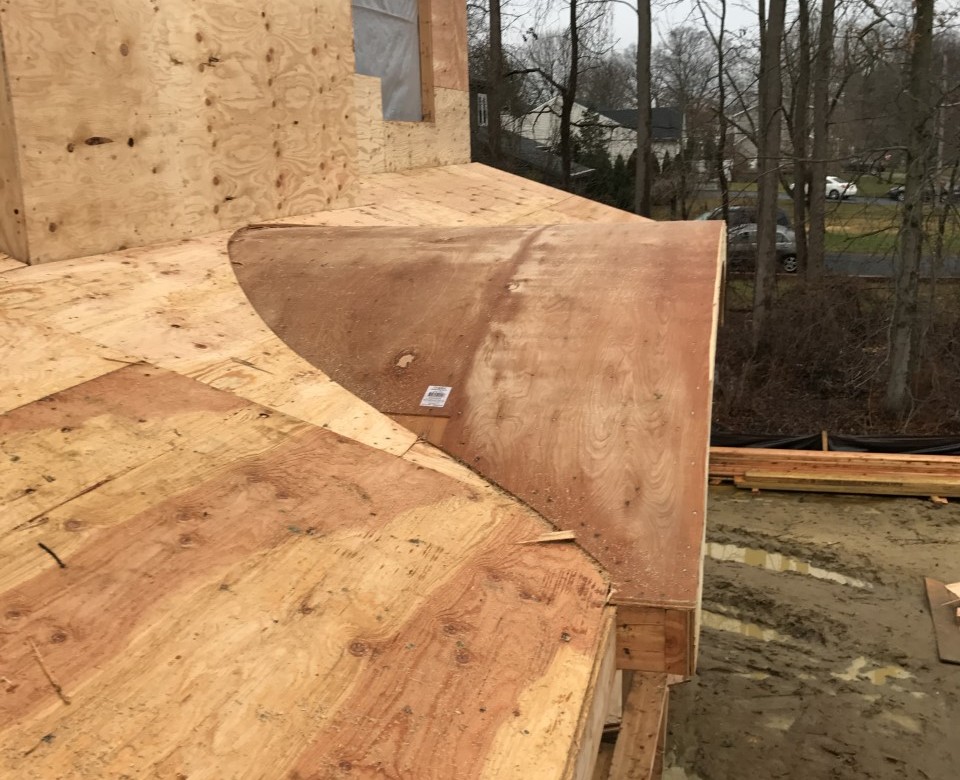The Importance Of Roof Sheathing
When most homeowners consider roofing parts, they probably think of shingles, gutters and maybe insulation. However, one important roof layer is often overlooked: the sheathing.
Roof sheathing is also known as roof decking. It is a crucial part of the entire roof structure as it helps to prevent an array of different issues and damages.
In addition to that, sheathing a roof can also help you prolong the roof’s lifespan and make your home more energy-efficient.
Read on to learn the proper roof sheathing definition and discover several reasons why roof sheathing is such a crucial component of your roof.
What Does Roof Sheathing Do?

So, what is roof sheathing, and what does roof sheathing do?
Roof sheathing – or decking – is an important layer of the roof that sits hidden underneath the top layer of the shingles. It is most commonly made out of plywood in the form of planks or roof boards, and the shingles are then attached to these.
A long time ago, before plywood and OSB boards, tongue-and-groove boards were used as roof sheathing material instead. Nowadays, tongue-and-groove boards are mostly used for decoration purposes.
These boards can be installed in two different ways and based on the installation method, we can differentiate between two types of roof sheathing. The sheathing can be either open, with gaps between the roof boards, or closed, with no gaps between them. This closed sheathing is also called solid sheathing.
Open sheathing is generally lighter and lower in cost, but solid sheathing panels are more efficient in protecting your roof from leaks; therefore, they are a better option for residential construction.
One more type of sheathing besides open and solid sheathing is concrete sheathing, which is considered a heavier material for roofs that need more strength and durability for heavy loads. In order to withstand heavy loads on the roof, metal reinforcement is added to the concrete sheathing.
Sheathing can be made out of wood panels, too.
Ultimately, the type of sheathing you and your roofer opt for will depend on the needs of your roof structure.
A Middletown roofing contractor can ensure that a homeowner’s sheathing is always properly installed and maintained.
What Benefits Does Roof Sheathing Offer?
The benefits of roof sheathing are tremendous. It adds strength and stability to the roof, which makes your home safe. Without sheathing, your roof would be more prone to leaks. Roof sheathing also helps with weight support, so your roof won’t sag due to something like a heavy snow load. Still, if a massive tree branch or limb falls on your roof due to severe weather, sheathing can be damaged.
Finally, roof sheathing (or decking) helps with fire protection. Its material is covered with fire retardant treatment, while concrete sheathing is a fireproof material by itself.
Roof Leak Prevention
Before sheathing became standard on new roofs, most roofs simply had a layer of boards underneath the shingles. The spaces between the roof boards were highly prone to leaking, and water damage was rampant on most roofs.
Sheathing solves this problem by providing a more continuous, solid layer beneath the shingles that has far fewer gaps or spaces. Proper sheathing is often the key difference between a roof that constantly leaks and a roof that hardly ever does.
Anchorage for Shingles
The sheathing layer is also a vital part of the support and structure for the rest of the roof. It provides an anchorage for the shingles to be firmly nailed to and, overall, an excellent foundation for all the external roof materials.
Materials such as asphalt shingles, metal panels, and metal shingles are smaller in size and require a broad and sturdy base where they can be safely and firmly attached. Sheathing provides great support for this exact purpose.
Roof sheathing thickness, i.e. the thickness of the plywood boards, is also an important consideration here. Their common thickness can vary and reach as much as 5 inches. And the thicker the boards are, the heavier and sturdier they will be.
This is important because heavier shingles will need heavier sheathing to support them adequately. Your roofer will ensure that the sheathing is as thick and sturdy as it should be, providing optimal structural support to the shingles.
Structural Support for the Entire Roof

In addition to anchoring the shingles, the sheathing provides broader roof support by evenly distributing any extra loads the roof may carry.
This includes snow and other accumulation. It also allows more hardware, such as solar panels, to be safely mounted on the roof without causing damage.
Roof sheathing is one of the first elements a contractor is likely to inspect when planning a solar or HVAC installation, for example. This is because the sheathing effectively disperses this extra weight across the rafters and other supporting elements of the roof. It prevents sagging and partial roof collapses.
Your local roofer will advise you on the best solution based on the state of your roof, its needs, the weather your area gets, and the amount of support the roof requires.
Generally, thicker sheathing will provide better load tolerance, as well as overall durable and long-lasting protection for the entire roof and your property.
What is the Minimum Thickness of Roof Sheathing?
Roof sheathing thickness is an important aspect of roof construction, as it contributes to the structural integrity and performance of the roof.
The minimum thickness of roof sheathing is between 1/2” and 5/8”, depending on the snow load in the area where the new roof is installed. It also depends on if you’ll be using plywood or oriental strand boards (OSB).
When you are deciding on the right thickness for your roofing, there are a few important factors to consider. Think of the type of roofing material you’re using and the spacing of the roof rafters or trusses.
It’s important you follow building codes in your area too. But there is a simpler option.
Let the roofing contractor take over and make the best decisions for your home. He should have the knowledge and experience needed to decide how thick the panels of your roof should be.
When Can the Sheathing Board Get Damaged?
Here are some of the most common signs of damaged roof sheathing you should be aware of:
Visible Sagging
Go outside and see if the roof line appears to sag or dip. This tends to happen especially between the rafters or trusses and it can be a sign of weakened or damaged sheathing.
Leaks or Water Damage
Have you noticed any leaks inside your home recently? Look for signs like water stains, peeling paint, or damp spots. These are indicators that your roof may be leaking and the sheathing could be compromised.
Daylight Coming Through the Roof
Sun rays are beautiful but you’re not supposed to see them in the attic.If you can see light shining through the roof, it’s a sign that your roof may be compromised. This could be due to missing shingles or severe deterioration of the sheathing.
Spongy or Bouncy Feel
If you’re walking on a roof and it feels spongy or bouncy, it could mean that the sheathing is weak or rotting. You should act on it as soon as possible because it could affect the safety and structural integrity of your entire roof.
Pests
Termites, ants, or rodents can harm the roof sheathing too. You can spot this by looking for droppings, nesting materials, or chewed wood.
Mold in the Attic
If you notice excessive mold growth in your attic, it’s a clear sign that there’s a problem. Look if there are any visible dark spots that could indicate the damage source.
Debris in the Gutters
Don’t forget to inspect your gutters for roof sheathing or shingle granules. Look for pieces of roof sheathing or a large amount of granules. These signs indicate something is wrong with your roof sheathing.
Increased Energy Bills
You probably won’t notice this on your roof, but you will in your wallet. Unexplained increases in your heating or cooling bills could be due to gaps in the roof sheathing.
If you aren’t sure whether the sheathing of your roof is damaged, the best way to check that out is to schedule a professional roof inspection.
How Often Should You Replace Your Roof Sheathing?
The lifespan of roof sheathing varies based on many factors. It mostly depends on the material quality you used and the installation process itself. Higher-quality materials generally have a longer lifespan. Well-ventilated attics and properly installed roofing materials help protect your sheathing long-term.
The climate you live in affects it too, and of course, regular maintenance can do wonders. In ideal conditions, good-quality sheathing can last as long as the roof itself.
But if you noticed some of the signs we mentioned above, it is time to inspect your sheathing. The good news is that most of the time, even if damaged, only a portion of the sheathing needs to be replaced. Your best move would be to hire a professional. They can determine whether a repair or a complete replacement is necessary.
How Much Does It Cost to Replace a Roof Sheathing?
It is impossible to give a simple answer because the price of your roof sheathing replacement will be based on factors such as:
- Material and Labor Costs
The price of sheathing materials varies depending on the type used. Plywood and OSB (oriented strand board) are common choices, with plywood generally being more expensive than OSB. The cost will depend on the quality of the material and market prices at the time of purchase. Labor costs can vary significantly based on your location, the complexity of the job, and the rates of the roofing contractor. People tend to overlook labor costs, even though they often constitute a significant portion of the total cost. If old sheathing needs to be removed, this can add to the labor cost as well. The condition of the existing roof can also impact how challenging it will be to remove the old sheathing.
- Size and Complexity of Your Roof
This one is pretty straightforward. The larger your roof is, the more material and labor you’ll need, and that will increase the overall cost.
Other than size, if your roof is complex, it will require more time and materials, which, of course, will cost you.
- Your Location
Roof sheathing replacement costs can depend on where you live too. Urban areas in general have higher labor costs. Also, if the demand is higher, so is the price. Don’t forget that local building codes can add to the cost, too.
To get an exact cost estimate for your roof, contact your local roofing professionals for an inspection first.
We know it can be overwhelming, but if you purchase quality materials and hire contractors for a proper installation, you will save money in the long run.
Reflective Roof Sheathing for a Cooler Home
Reflective roof sheathing provides better thermal protection for homes by reflecting the sun and preventing the attic from overheating.
The attic is known to overheat during the summer because the sun’s energy is absorbed by the shingles, therefore transferred to the attic. This, in turn, causes the entire home to heat up, leading to higher cooling needs and energy consumption.
With reflective roof sheathing, on the other hand, the heat transfer from the shingles to the attic will be significantly decreased, leading to a cooler home, lower energy consumption, and reduced cooling costs.
This can all be achieved simply by installing a radiant barrier on the sheathing. The radiant barrier will help make the home more energy-efficient, which is especially useful in hot climates or on buildings that may have less insulation.
Roof Sheathing Installation

Sheathing a roof is a crucial process in installing a new roof or replacing your old one, because – together with shingles – the sheathing works to fully protect your roof from water damage.
Roof sheathing is also an important roof element to inspect and maintain on a regular basis.
Properly maintained shingles should adequately protect the sheathing from water and exposure. However, if the shingle layer becomes damaged or if shingles are torn or missing, the vulnerable plywood sheathing may be exposed.
Even if the sheathing does its job to prevent leaks, water may soak into the plywood, leading to rot and failure. Ensuring the sheathing is in good condition is an important part of any professional roof inspection.
The Top GAF Master Elite Roofer in Town
Have a question regarding roof repairs or skylight installations? Or if you suspect your home has damaged or old sheathing, ask a roofing professional from Fortified Roofing for help.

Rated 4.7 out of 5 stars based on 8 customer reviews.

Oh My! People say such nice things!
